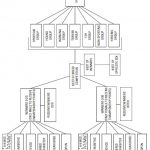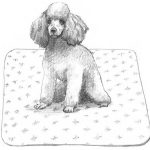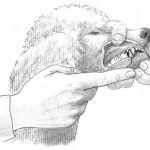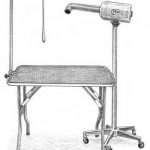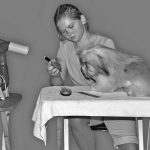Welcoming Your Poodle Home

In This Chapter
- Taking your Poodle home
- Showing your Poodle around the house
- Introducing family members (of all kinds) to your Poodle
- Getting through the first night
- Anticipating and solving potential problems
If you’re jumping into this chapter, you’ve most likely chosen the Poodle that’s right for you. Congratulations! (If not, you can head to Chapter Deciding Whether a Poodle Is Right for You to find out how.) This chapter gives you tips for picking up your Poodle and introducing her to the rest of the family, to other pets, and to her designated spaces (see Chapter Choosing the Best Poodle for You), all with a minimal level of stress for both of you. I also show you how to make it through the first night with ease and how to handle any problems that may crop up at the outset.
Picking Up Your Poodle
Selecting the right day and the right time
Warning!
If you want to get your Poodle on a Friday, go as early in the afternoon as you can. If you go too late in the day, your Poodle may only have time for a quick tour before bedtime, which may make it harder for her to get to sleep. Even if you do follow this advice, though, odds are your puppy will cry the first night or two. Even an adult Poodle that you adopt may whine a bit.
Taking home other items besides the Poodle
– A three-generation pedigree
– The American Kennel Club (AKC) registration slip (see Chapter Socializing Your Poodle for more information on the AKC and Chapter Deciding Whether a Poodle Is Right for You for more on pedigrees and registrations)
– Your puppy’s health record and health guarantee
– A sales contract
– A two- or three-day supply of whatever food your puppy has been eating
Remember
As long as you know what kind of food your puppy has been eating, you can get your own if the breeder doesn’t offer some. However, you should make sure that you leave with a bill of sale (and/or a contract), the registration slip, and the health information. Don’t pay for and accept a puppy without these items.
Remember
Whatever else your breeder gives you, the most important extra item you can get is his phone number. Reputable breeders want the best for their puppies and for the people who buy them.
Traveling home safely
Is it wise to get a Christmas puppy?Christmas has long been the one holiday that is not considered a good time to get a new puppy. Many breeders refuse to sell puppies two weeks before or two weeks after Christmas. The reason for this reluctance is that Christmas is a hectic time, with a lot of activities, friends, and relatives hustling in and out, leaving little time for puppy care. Puppies need structure, especially as housetraining begins, and the Christmas break may not allow for that structure. Lately, some shelters have found that if a family fully understands the demands of a new pet, the Christmas break gives the family the time it needs with the pet, and the adoption works quite well. If you think Christmas break can work, consider the age of your children. For families with very young children, I still say Christmas is a bad time. For homes with older children or adults-only homes, it may work, but Christmas time still wouldn’t be my first choice. In fact, I’d prefer getting a puppy when housetraining didn’t mean bundling up and wading through snowdrifts every hour or two. And, no matter what anyone says, Christmas Day is too hectic for getting a puppy. Put a lead and a collar, dog dishes, or a training book (or this book!) under the tree, and pick up your puppy the week after Christmas. |
Giving Your Poodle the Grand Tour
1. The eating spot: Take your Poodle to the spot you’ve chosen for her food and water dishes (Chapter Choosing the Best Poodle for You lets you know what kind of dishes to buy). Give her a chance to take a drink, if she wants one. Put a few tasty treats in her bowl. Don’t worry if she doesn’t eat them; she may be too overwhelmed, but at least she knows that she’s in the right spot for food. (See Chapter Making a Match with a Poodle for more on a Poodle’s diet.)
2. The sleeping spot: The next stop should be your Poodle’s bed, which may be her crate at first (see Chapter Choosing the Best Poodle for You for info on buying bedding). Wherever you’ve decided to put her crate, take your Poodle to that spot, and put her in her crate. Depending on how long the trip was from the breeder (or shelter) to your home, you may want to let her have a little rest. Keep people and other pets away from the crate and let her have a nap.
3. The potty spot: When the nap is over, take your Poodle directly to her potty spot. If your Poodle went to the bathroom in the yard when you first got home, take her back to that same area. Her nose can tell her that she’s in the right spot. If she goes, praise her.
If you’ve decided that you’re going to paper-train your Poodle or teach her to use a litter box, take her to the appropriate area indoors. Your puppy may have a few accidents before she becomes housetrained, but the sooner you start taking her to the appropriate area and the sooner she starts using it, the faster and easier housetraining is. (Head to Chapter Keeping Your Poodle Clean and Attractive for full details on housetraining.)
Meeting Other Family Members
Kids in the house
Warning!
Never leave a baby alone with a dog. Babies are even more defenseless than puppies. Dogs can nip, and nails can scratch, and in more serious situations, a baby’s high-pitched noises can trigger a dog’s instinctive response to nearby prey. Introduce your baby and Poodle, but never leave them alone together.
Tip
Depending on the age of your kids, you may want to let them help care for the Poodle. Even children under the age of 7 may be able to fill the water dish. A child of 10 or 12 can take the dog out to the yard or feed her. Just remember that your Poodle is a living entity, and that you’re responsible for her care. If your children forget their dog chores, you still need to make sure your Poodle is fed, watered, and exercised. If you have a puppy, make sure you leave housetraining chores to adults or teenagers who have a better sense of how to stick to a schedule.
Remember
You need to use caution when introducing an adult Poodle as well. A full-grown Standard Poodle can intimidate a small child, not to mention knock him down. Sit the child in a chair, and keep the dog on her lead for introductions. As with puppies, allow no grabbing or pulling of any part of the dog.
Other pets
Other dogs
Remember
Introduce your resident dog to the new dog out in the yard, not in the house. Your current dog may be more territorial in the house. If you have more than one dog, let them meet the newcomer individually. Supervise the introductions. You don’t have to leash your resident dog, but if you feel safer with the dogs on leads, keep the leads loose. Sometimes, a dog on a lead can be more aggressive than one that’s loose — especially if the lead is tight.
Tip
Even if introductions go smoothly, be careful that the puppy doesn’t try to eat from the adult dog’s food dish. Even friendly dogs can get cranky if another dog tries to steal their food. Give treats separately for the same reason.
Cats and smaller animals
Remember
If your cat isn’t used to dogs, you should take things even slower. Use the following steps to introduce your Poodle to your feline:
1. Before you bring the Poodle into the house, put your cat in a room and close the door.
2. Let the cat and the dog get to know each other by way of the crack under the door. Let them sniff each other.
3. When you finally open the door, make sure the Poodle is in her crate or in an exercise pen (see Chapter Choosing the Best Poodle for You). This way, the cat can approach the dog at his own pace, and the dog can’t chase or pounce on the cat.
Tip
If you have a friend with a cat-friendly dog, invite your friend and dog over for a visit before you bring your Poodle home. Your cat doesn’t have to actually meet the dog, but it may help get him used to the idea of a dog.
– Make sure that your cat always has a place to escape the Poodle’s attentions. Put a baby gate in a doorway of a “safe room.” Your cat can jump in, but your Poodle is kept out.
– If putting up a gate isn’t possible, make sure your cat has a high area in every room for escaping purposes. Clear off the top of a dresser or a shelf on a bookcase.
– Don’t let either animal pester the other when they’re eating or using the litter box. And speaking of the litter box, you may want to keep it out of your Poodle’s reach for another reason. Many dogs consider litter-box contents a tasty treat. (Eeeewww!)
Remember
You’ve probably seen pictures of a dog snuggling a rabbit or a parakeet sitting on a dog’s head, but these images are the exceptions. Protect your other pets from your dog. Put cages up high so that your dog can’t reach them, or put them in a room that’s off limits to the dog. If you like to let your bird out for exercise or want your bunny out for playtime, put your dog in her crate.
Surviving the First Night
Tip
You can try a few of the following tips to help make your Poodle comfortable and more willing to settle down and go to sleep:
– Give her a little something to eat. She’s more apt to curl up and fall asleep if she’s full.
– Take her out for a final potty break before bedtime.
– Make sure her bed is warm and cozy. If she gets cold, she may wake up, and if she wakes up, chances are you need to make another trip to the yard.
– A ticking clock may help to calm your Poodle. Wrap the clock in an old towel or soft shirt. You also can purchase beds and pillows that produce the sound of a heartbeat for up to 30 minutes.
Tip
Many breeders begin crate training at seven weeks, teaching the puppies to spend time alone in a crate away from the litter. This makes it much easier for a puppy to adjust to a new home away from littermates. Ask your breeder if he does this or can do this with your puppy so that the change of scenery isn’t so sudden and stressful.
Anticipating Possible Problems and Planning Sensible Solutions
Avoiding bad habits from the outset
Tip
If you bring home an adult Poodle, she may already have certain habits. If she’s used to sleeping on the couch, but you don’t want her to continue this habit, be firm and consistent about removing her. Encourage her to lie in a special spot by giving her treats and plenty of praise. You also can cover your sofa with a washable throw and let her sleep there if the habit proves hard to break.
Remember
You don’t have to be an ogre, but be firm and consistent, and start her training immediately. If you have questions about behavior, call your breeder for advice. Put his number on speed dial now. (See Chapter Housetraining Made Easy for tips on instilling good manners in your Poodle.)
Handling food issues
– Sometimes, a food that’s perfect for all the other puppies in the litter is just too rich for one of them. If your puppy is regurgitating her food, this could be why. If she seems healthy otherwise, she’s active, and she has no temperature, her problem may be the food. Gradually (over the span of a week) switch to another food. If your Poodle still has a problem, see your veterinarian. (Chapter Taking Basic Care of Your Poodle’s Health has tips on selecting the right vet for your Poodle.)
– Another consideration is that your Poodle is being too active right after a meal. Let your dog rest or quietly explore right after a meal, and discourage rough and tumble games.
Getting used to grooming
Tip
Grooming is going to be a big part of your Poodle’s life. Whether you intend to show your Poodle (see Chapter Showing Off and Enjoying Your Poodle’s Talents) or just keep her in a pet clip, you have a lot of brushing and trimming ahead of you. Start with the following tips:
– Handle your Poodle’s feet daily. You don’t need to actually cut her nails, but hold her paws in your hand. Give her treats. If you plan to use a grinder instead of nail clippers, turn on the grinder and hold one of your dog’s paw on it. Let her feel the vibration and get used to the noise.
– Brush your dog daily. This beauty routine doesn’t have to be a full grooming session. Just run the brush over her body. Start teaching her to hold still while you brush. She can either stand or lie down for these brief grooming sessions. As an adult — especially if your dog is a Standard Poodle — grooming takes some time, and she may be more comfortable lying down. If you intend to groom your Poodle yourself, invest in a grooming table.
by Susan M.Ewing







